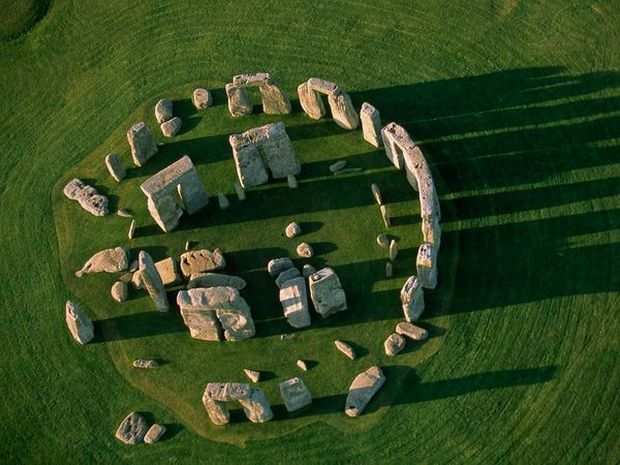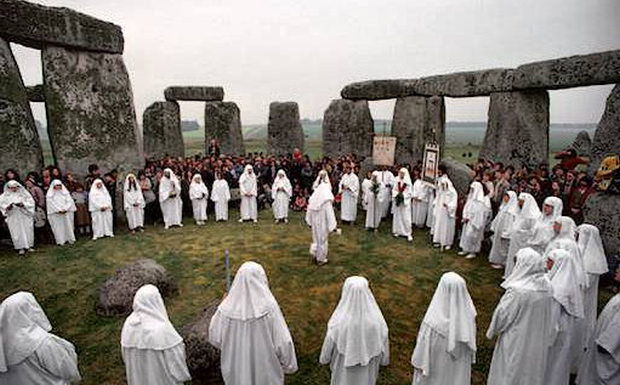An enduring monument to bygone mysteries of religion and science, the great megalithic circle of giant stone slabs at Stonehenge provides the modern world with a timeless puzzle, an architectural wonder and a tribute to the human imagination. Was it a sacred burial ground or a prehistoric observatory? Standing starkly in the middle of Salisbury Plain, Wiltshire, Stonehenge presents a riddle that seems as old as time itself. One of the loveliest cathedrals in England, Salisbury, lies only 10 miles (16km) away, yet the seven or so centuries that have passed since Salisbury Cathedral was built are a brief span beside the antiquity of these huge and ancient stones.
The extraordinary concentric stone circles that occupy the site today represent many thousands of years of archaeological changes. Bridging the Late Stone Age and Early Bronze Age, the monument was constructed in three or even four stages over a period of roughly 500 years, though mainly between 1800 and 1400 BC. But what remains of Stonehenge today is but a shadow of its former glory. More than half the stones have either fallen, or are missing, or lie buried.

Building was begun as early as 3100 BC (some experts claim 3800 BC), when a vast circular ditch was dug and 56 pits excavated inside its earthern bank. Named Aubrey Holes after their 17th-century discoverer John Aubrey, the pits have been capped with concrete, but the first gigantic stone to be placed, the Heel Stone – marking the entrance to the earthernworks – is said to stand in its original position. Two further rings of pits, the Y and Z holes – which may have had some astronomical significance – lie between the Aubrey Holes and the massive stone circles in the centre.
Around 2100 BC, 80 bluestones were brought from Wales and formed into two concentric circles. These were later replaced by a circle of 30 huge sandstone monoliths called sarsens. Within this grand circle stood two partial horseshoe formations, the outer consisting of five sarsen trilithons (two upright stones with a third placed across the top) and the inner of 19 shaped bluestones. The only digging tools of the Neolithic creators were pickaxes made from the antlers of red deer, so their architectural achievement is astonishing.
The Saxons named the megalith Stonehenge – the word means ‘Hanging Stone’ – while medieval scribes referred to it poetically as ‘the Giant’s Dance’. Although scholarly observers were in general agreed about the site’s mystical associations, none was clear about its true purpose. The 17th-century architect Inigo Jones, for example, argued that the stones were the remains of a Roman temple, but 18th and 19th-century opinion held firm that the stone circle was a Druid temple where sun-worship and human sacrifice were practiced. This is unlikely, however, since Stonehenge was completed at least 1000 years before the Druid cult flourished.
A privileged caste of priests who trained for up to 20 years in preparation for their duties as guardians of sacred lore, the druids were masters of magic and manipulators of supernatural forces. Besides their priestly role, the Druids also administered justice and guided the actions of the ruling Celtic chiefs or kings of Britain, Ireland and France.

The name druid is Celtic for ‘knowing the oak tree’, and worshippers often performed their rites in densely wooded areas. Robed in white, they revered a multitude of martial gods and goddesses, offering them both human and animal sacrifices to mark seasonal festivities. In the first century BC Julius Caesar wrote extensively of Druid activities, particularly of the sinister ritual sacrifices that struck terror into the hearts of all Celts.
The Celts believed that the soul resided in the head and feared that a severed head – which retained a person’s consciousness – might be used for magical purposes. Druids were known to have preserved severed heads, and dried heads have been found at some ancient Druid sites. Modern Druids still hold rituals at Stonehenge – at sunrise in mid-summer and sunset in mid-winter. These ceremonies were once banned, but have been reinstated since the late 1990s.
The first glimmer of truth about the site only came to light in the 20th-century, when archaeologists established the real age of the monument and arrived at more realistic conclusions about its original purpose. But the known facts are still few.
The sarsens of the outer ring, which stand 18ft (6m) tall and weigh around 25 tons apiece, were hauled from the Marlborough Downs, about 20 miles (32km) away, and meticulously arranged so that lintels and uprights, linked by ball and socket joints, met securely. The bluestones from the Preseli Hills in south-west Wales, weighing up to 5 tons each, were probably ferried by raft around the Welsh coast and up the River Avon, then dragged overland.

But what purpose did all this effort serve? Pointing to the number of ancient earthworks located in this area, which has the greatest concentration of circular mound tombs in Britain, most archaeologists today maintain that Stonehenge was a ceremonial ground. Evidence of cremations has been found in many of the Aubrey Holes, but proof also exists that the holes were dug long before and cremated remains were placed in them. They might have been intended for ritual libations, such as wine, poured into the holes by devout agricultural workers to appease the gods of nature, and the stone circles might have formed a temple of sorts for ceremonial worship.
More recently, astronomers claiming to have ‘decoded’ the stones propose that Stonehenge is a prehistoric computer, an astronomical calendar or an astrological calculator, since the alignments of the stones seem to bear a direct relationship to the movements of the sun, moon and planets and their ever-shifting relationships. The alignment of the stones provides precise sightlines for the rising and setting of the sun and moon on key dates, notably the summer and winter solstices. Pagan priests may have used the 30 Y holes and 29 Z holes to count alternate months.
Stonehenge is one of the most frequently visited archaeological sites in the world and has been carefully excavated and restored. In recent years, however, there has been increasing concern over potential damage to the monument caused by its large number of visitors. The central circle has been now been enclosed and public access is strictly limited, while a major conservation project will see the construction of a tunnel to conceal the nearby busy road.
While mathematical and statistical evidence can be produced to support nearly every new theory, no single theory has yet solved the riddle of Stonehenge’s fabled past.
-end-




































